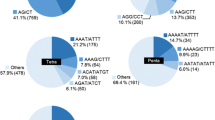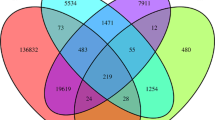Abstract
Indian lettuce (Lactuca indica L.) is an undomesticated wild plant with high economic potential. We know little about the plant’s genome, such as its DNA markers, making genetic research using this plant difficult. In this study, 100 genic simple sequence repeat (SSR) primers with a 99–250 bp target amplicon were synthesized from L. indica transcriptomic sequences. These primers were examined in 8 diverse L. indica accessions, and 90 polymorphic SSRs were obtained. Twenty-three of the 90 polymorphic SSRs were used to investigate transferability to another two Lactuca species, Lactuca serriola and Lactuca sativa. Genetic diversity was investigated in 77 Lactuca accessions, including 73 L. indica collected from across South Korea, 2 L. serriola, and 2 L. sativa. Our genic-SSR markers were highly polymorphic with a mean polymorphic information content of 0.61 and, on average, 10.83 alleles per locus. The average expected heterozygosity (0.76) was higher than the observed heterozygosity. An analysis of molecular variance revealed that most of the total variance in our population is attributable to genetic variation among accessions, rather than among provinces. STRUCTURE, unweighted neighbor-joining phylogenetic trees, and principal coordinate analyses resulted in three clusters, where northern and central-southern L. indica accessions were grouped into two clusters with some admixture. The L. serriola and L. sativa accessions did not produce a separate cluster due to a small sample size. These results show our SSR markers will be useful in germplasm assessment and genetic studies of L. indica and other Lactuca species.



Similar content being viewed by others
References
Bown D (1995) The Royal Horticultural Society encyclopedia of herbs and their uses. Dorling Kindersley Limited, London
Earl DA, Vonholdt BM (2012) STRUCTURE HARVESTER: a website and program for visualizing STRUCTURE output and implementing the Evanno method. Conserv Genet Resour 4:359–361
El-Esawi MA (2015) Molecular genetic markers for assessing the genetic variation and relationships in Lactuca germplasm. Annu Rev Res Biol 8:1–13
El-Esawi MA, Sammour R (2014) Karyological and phylogenetic studies in the genus Lactuca L. (Asteraceae). Cytologia 79:269–275
Evanno G, Regnaut S, Goudet J (2005) Detecting the number of clusters of individuals using the software STRUCTURE: a simulation study. Mol Ecol 14:2611–2620
Facciola S (1990) Cornucopia: a source book of edible plants. Kampong Publ., Vista
Ha J, Lee T, Kim MY, Oliya BK, Gwag J-G, Lee Y-H, Lee S-H (2017) Comprehensive transcriptome analysis of Lactuca indica L., a traditional medicinal wild plant. Mol Breed 37:112. https://doi.org/10.1007/s11032-017-0711-z
Hill M, Witsenboer H, Zabeau M, Vos P, Kesseli R, Michelmore R (1996) PCR-based fingerprinting using AFLPs as a tool for studying genetic relationships in Lactuca spp. Theor Appl Genet 93:1202–1210
Jeffrey C (1966) Notes on the Compositae: I. The Cichorieae in East Tropical Africa. Kew Bull 18:427–486
Kesseli R, Ochoa O, Michelmore R (1991) Variation at RFLP loci in Lactuca spp. and origin of cultivated lettuce (Lactuca sativa). Genome 34:430–436
Kim KH, Kim YH, Lee KR (2007) Isolation of quinic acid derivatives and flavonoids from the aerial parts of Lactuca indica L. and their hepatoprotective activity in vitro. Bioorg Med Chem Lett 17:6739–6743
Kitner M, Lebeda A, Dolezalova I, Maras M, Kristova E, Nevo E, Pavlicek T, Meglic V, Beharav A (2008) AFLP analysis of Lactuca saligna germplasm collections from four European and three Middle Eastern countries. Isr J Plant Sci 56:185–193
Koopman WJ, Guetta E, van de Wiel CC, Vosman B, van den Berg RG (1998) Phylogenetic relationships among Lactuca (Asteraceae) species and related genera based on ITS-1 DNA sequences. Am J Bot 85:1517–1530
Lebeda A, Dolezalova I, Kristkova E, Kitner M, Petrzelova I, Mieslerova B, Novotna A (2009) Wild Lactuca germplasm for lettuce breeding: current status, gaps and challenges. Euphytica 170:15–34
Loveless MD, Hamrick JL (1984) Ecological determinants of genetic-structure in plant-populations. Annu Rev Ecol Syst 15:65–95
Michalska K, Stojakowska A, Malarz J, Doležalová I, Lebeda A, Kisiel W (2009) Systematic implications of sesquiterpene lactones in Lactuca species. Biochem Syst Ecol 37:174–179
Nybom H, Weising K, Rotter B (2014) DNA fingerprinting in botany: past, present, future. Investig Genet 5:1. https://doi.org/10.1186/2041-2223-5-1
Peakall R, Smouse PE (2012) GENALEX 6: genetic analysis in Excel. Population genetic software for teaching and research. Mol Ecol Notes 6:288–295
Pritchard JK, Stephens M, Donnelly P (2000) Inference of population structure using multilocus genotype data. Genetics 155:945–959
Riar DS, Rustgi S, Burke IC, Gill KS, Yenish JP (2010) EST–SSR development from 5 Lactuca species and their use in studying genetic diversity among L. serriola biotypes. J Hered 102:17–28
Seo MW, Yang DS, Kays SJ, Lee GP, Park KW (2009) Sesquiterpene lactones and bitterness in Korean leaf lettuce cultivars. Hortic Sci 44:246–249
Tamura K, Stecher G, Peterson D, Filipski A, Kumar S (2013) MEGA6: molecular evolutionary genetics analysis version 6.0. Mol Biol Evol 30:2725–2729
Untergasser A, Cutcutache I, Koressaar T, Ye J, Faircloth BC, Remm M, Rozen SG (2012) Primer3—new capabilities and interfaces. Nucleic Acids Res 40:e115. https://doi.org/10.1093/nar/gks596
van Treuren R, van der Arend AJM, Schut JW (2011) Distribution of downy mildew (Bremia lactucae Regel) resistances in a genebank collection of lettuce and its wild relatives. Plant Genet Resour 11:15–25
van de Wiel C, Arens P, Vosman B (1999) Microsatellite retrieval in lettuce (Lactuca sativa L.). Genome 42:139–149
Varshney RK, Graner A, Sorrells ME (2005a) Genic microsatellite markers in plants: features and applications. Trends Biotechnol 23:48–55
Varshney RK, Sigmund R, Börner A, Korzun V, Stein N, Sorrells ME, Langridge P, Graner A (2005b) Interspecific transferability and comparative mapping of barley EST–SSR markers in wheat, rye and rice. Plant Sci 168:195–202
Wang SY, Chang HN, Lin KT, Lo CP, Yang NS, Shyur LF (2003) Antioxidant properties and phytochemical characteristics of extracts from Lactuca indica. J Agric Food Chem 51:1506–1512
Wei WL, Qi X, Wang L, Zhang Y, Hua W, Li D, Lv H, Zhang X (2011) Characterization of the sesame (Sesamum indicum L.) global transcriptome using Illumina paired-end sequencing and development of EST–SSR markers. BMC Genom 12:451. https://doi.org/10.1186/1471-2164-12-451
Wei Z, Zhu SX, Van den Berg RG, Bakker FT, Schranz ME (2017) Phylogenetic relationships within Lactuca L. (Asteraceae), including African species, based on chloroplast DNA sequence comparisons. Genet Resour Crop Evol 64:55–71
Witsenboer H, Michelmore RW, Vogel J (1997) Identification, genetic localization, and allelic diversity of selectively amplified microsatellite polymorphic loci in lettuce and wild relatives (Lactuca spp.). Genome 40:923–936
Wright S (1978) Evolution and the genetics of populations: variability within and among natural populations. University of Chicago Press, Chicago
Zhang J, Wu K, Zeng S, da Silva JA, Zhao X, Tian CE, Xia H, Duan J (2013) Transcriptome analysis of Cymbidium sinense and its application to the identification of genes associated with floral development. BMC Genom 14:279. https://doi.org/10.1186/1471-2164-14-279
Yeh FC, Yang R, Boyle T, Ye Z, Mao JX (1999) POPGENE, version 1.32: Microsoft window-based free ware for population genetic analysis. Computer program and documentation distributed by University of Alberta and Centre for International Forestry Research, Alberta, Canada
Acknowledgements
This work was supported by a Grant from the Next Generation BioGreen 21 Program (Code No. PJ01326101), Rural Development Administration, Republic of Korea.
Author information
Authors and Affiliations
Corresponding author
Ethics declarations
Conflict of interest
Bal Kumari Oliya declares that she does not have conflict of interest. Moon Young Kim declares that she does not have conflict of interest. Suk-Ha Lee declares that he does not have conflict of interest.
Electronic supplementary material
Below is the link to the electronic supplementary material.
Rights and permissions
About this article
Cite this article
Oliya, B.K., Kim, M.Y. & Lee, SH. Development of genic-SSR markers and genetic diversity of Indian lettuce (Lactuca indica L.) in South Korea. Genes Genom 40, 615–623 (2018). https://doi.org/10.1007/s13258-018-0660-x
Received:
Accepted:
Published:
Issue Date:
DOI: https://doi.org/10.1007/s13258-018-0660-x




